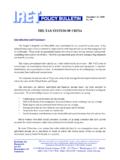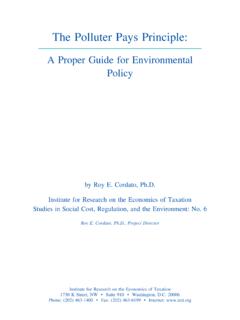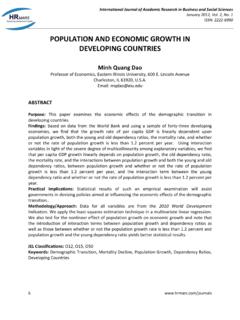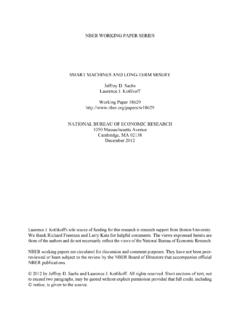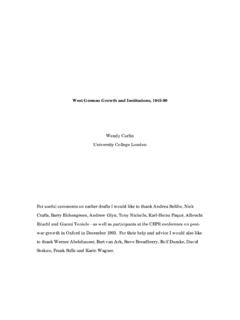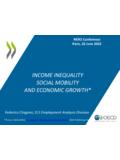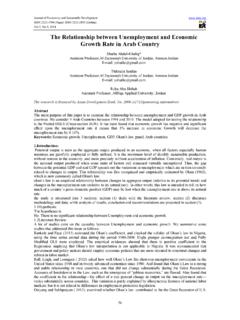Transcription of TAX INCIDENCE, TAX BURDEN, AND TAX …
1 Institute forResearchon theEconomics ofTaxationIRET is a non-profit, tax exempt 501(c)3 economic policy research and educationalorganization devoted to informing the public about policies that will promoteeconomic growth and efficient operation of the market Rhode Island Avenue, , 11th Floor Washington, 20036(202) 463-1400 Fax (202) 463-6199 Internet September 10, 2004 No. 88 TAX incidence , TAX burden , and tax SHIFTING:WHO REALLY PAYS THE TAX?EXECUTIVE SUMMARYThe current tax system imposes heavier taxes on income used for saving and investment, andon the formation of human capital, than on income used for consumption. These tax disincentivesto save and invest, to work and take risks have consequences. They lead people to under-save andover-consume, and to work less and play more. These adverse effects strongly urge us to disposeof the current income tax structure and replace it with a flat rate tax that is neutral in its treatmentof saving and consumption.
2 A tax system that is saving-consumption neutral would lead to asignificant increase in income across the tax biases against saving and investment and the current system's steeply graduated tax ratestructure were introduced for the purpose of improving "social equity". It has been assumed that theadded layers of tax on income used for capital formation would do little economic damage, wouldharm only the wealthy, and would provide significant income redistribution. It has become apparent,however, that most of the taxes that seem to fall on those who supply physical capital, intellectualcapital, or special talents to the production process may actually be shifted to ordinary workers andlower income retirees in the form of reduced pre-tax and after-tax political battles over proposed tax changes often turn on the question of who would gainand who would lose.
3 Answers to such questions are supposedly presented in so-called "burdentables" prepared by the Treasury, the Joint Committee on Taxation, the Congressional Budget Office, and tax researchers. The adverse economic consequences of non-neutral taxation and graduated taxrates, and the resulting adverse impact on "social equity", are not displayed in the burden bad information, the public and the Congress are left with a bad tax system and a burden tables claim to show the distribution of the tax burden across taxpayers orhouseholds of varying income levels. In fact, the tables try only to show the initial incidence of atax or a tax change on the after-tax incomes of those assumed to pay it. They do not examinePage iiits ultimate burden , which depends upon the subsequent reactions of the initial taxpayers, whomay change how much they work, save, consume, invest, or hire, all of which affect the incomesof other people in the true measure of the burden of a tax is the change in people s economic situations as aresult of the tax after all economic adjustments are taken into account.
4 Unfortunately, the burdentables are based on static economic assumptions that ignore most of the economic consequencesof assumptions are often adopted more for ease of computation than foreconomic accuracy. No burden table ever published has been based on how taxes truly tables ignore the fact that the tax on one factor of production can hurt another factorof production. A tax imposed on a truck owner s returns on his fleet, which reduces the numberof trucks he can afford to run, hurts the truck drivers who are laid off. If a tax is imposed onthe truck drivers wages, the fleet owner must pay them extra or risk their dropping out of thelabor force, which would leave trucks idle in the garage, earning table analysts assume that the corporate income tax is borne by the owners of capital,and that income taxes on the earnings of saving are borne by the savers.
5 However, capital isvery sensitive to taxation and to the after-tax rate of return. Taxation of corporate and othercapital income results in a reduction in capital formation, which restores the normal rate of returnto the remaining capital, but which reduces the productivity of workers and lowers their tax on capital income is largely shifted to labor. Indeed, a significant body of tax literaturemakes the case that workers would have a higher after-tax wage if capital income were not taxed,even if the workers had to pay a higher tax rate to pick up the initial revenue cost to thegovernment of eliminating taxes on capital graduated marginal tax rates supposedly hurt the rich, and the burden tables reflect thatassumption. However, high tax rates discourage the efforts of people with the greatest humancapital and sharpest entrepreneurial skills.
6 As these individuals reduce their activity, other peoplewho would normally work with them become less productive and lose income as well. Someof the tax on skilled workers and entrepreneurs is shifted to the unskilled. For example, highgraduated marginal tax rate on physicians incomes may induce some doctors to retire, or to workshorter hours by sharing a practice, and inevitably lead to higher medical fees. Fewer doctorsmean fewer jobs for nurses and support staff, longer waits for patients, and higher medical costsfor patients and government health tables even do a bad job of showing the initial incidence of a tax. burden tablesassume that income taxes are borne solely by the workers, savers, and investors on whom the taxis initially imposed (the tax is completely "passed back" to suppliers of labor and capital, andPage iiinone falls on the consumers of their products), while consumption taxes, such as excise and salestaxes, are borne by the consumers of the products (the tax is completely "passed forward" tobuyers, and none falls on the producers of the product).
7 These contrary assumptions are at oddswith basic economics, which clearly reveals that all taxes are split in some fashion betweenproducers and consumers except in the rare cases of perfectly inelastic supply or demand forgoods or tables are snapshots in time. They do not reveal that people move up and down inthe income distribution over time. They show the incidence of a tax change only on thoseaffected today, and ignore gains or losses to other taxpayers in the future. For example, theburden tables report that the recent reduction in the taxation of dividends and capital gains is ofbenefit to current shareholders and sellers of assets. The tables do not reveal that millions ofpeople who do not own shares or sell assets in the year in question will do so later in their lives,and that the long run benefits of the tax change are far more widely distributed than a one yearsnapshot indicates.
8 Furthermore, the tables make no estimate of how the reduced taxation ofcapital income will boost capital formation and raise wages for those who never own shares orsell burden tables do not show how taxes affect economic activity, employment, andinvestment, they do not provide policy makers with a realistic picture of what taxes do topeople s incomes and welfare. By ignoring the widespread benefits of incentive-enhancing taxreduction, the tables fuel class warfare and impede the adoption of major tax reforms that wouldincrease capital formation, raise labor productivity, and raise incomes across the better understanding of the economic consequences of taxation would benefit the Treasuryand the Congress as they plan the federal budget and as they contemplate changes in the taxsystem.
9 The same information needed to produce accurate burden tables, tables that correctlyproject the consequences of tax changes for people s incomes, is also needed to correctly forecastthe effect of a tax change on the federal budget. Dynamic scoring of tax changes would showthat pro-growth tax changes would cost less than static analysis indicates, and that anti-growthtax rate increases would raise less revenue than more rational system of calculating and displaying the real tax burden , one that took fullaccount of how taxes are shifted, would make it easier to explain and adopt a more rational taxsystem. A more rational tax system, in turn, would maximize the efficiency of the economy asa whole, and would enable every individual to maximize his or her potential lifetime productivityand INCIDENCE, incidence , TAXTAX BURDEN, burden , ANDAND TAXTAX SHIFTING:SHIFTING:WHOWHO REALLYREALLY PAYSPAYS THETHE TAX?
10 TAX?I. IntroductionWho pays the income tax, the payroll tax, the estate and gift taxes? Who bears the burdenof the gasoline and tobacco taxes? If Congress were to raise this tax rate, or lower that taxdeduction, who would gain and who would lose? The outcomes of the political battles overchanges to the tax system often hinge on the answers to such demonstrate who pays current taxes or who would be the winners and losers from a taxchange, the Joint Committee on Taxation of the Congress (JCT) produces " burden tables" showinghow much money everyone sends, or would send, to the Treasury. Winners and losers are groupedby their adjusted gross income class, and the distributional impacts of a tax, or a tax change, aredisplayed. burden tables are also prepared on occasion by the Treasury and the CongressionalBudget Office, as well as private research groups, using sometimes similar, sometimes differentassumptions and methods of display (such as by "income quintile").
